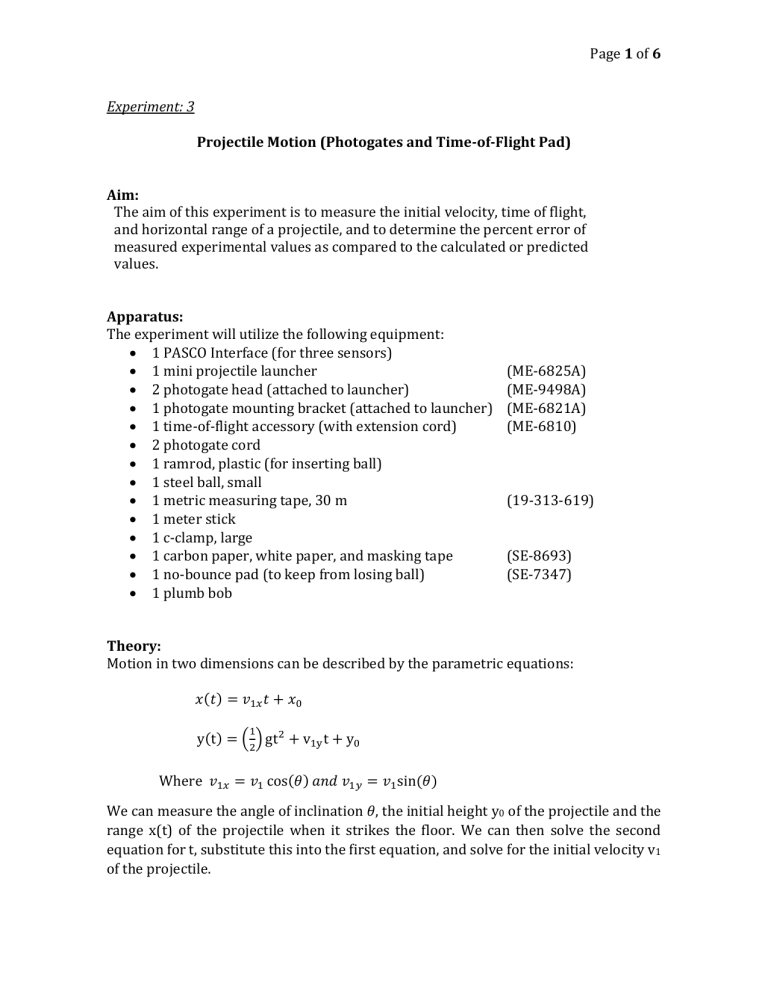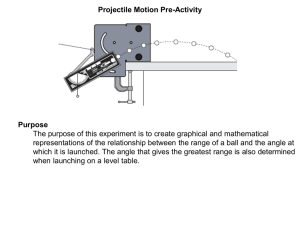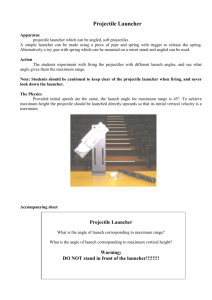
Page 1 of 6 Experiment: 3 Projectile Motion (Photogates and Time-of-Flight Pad) Aim: The aim of this experiment is to measure the initial velocity, time of flight, and horizontal range of a projectile, and to determine the percent error of measured experimental values as compared to the calculated or predicted values. Apparatus: The experiment will utilize the following equipment: 1 PASCO Interface (for three sensors) 1 mini projectile launcher 2 photogate head (attached to launcher) 1 photogate mounting bracket (attached to launcher) 1 time-of-flight accessory (with extension cord) 2 photogate cord 1 ramrod, plastic (for inserting ball) 1 steel ball, small 1 metric measuring tape, 30 m 1 meter stick 1 c-clamp, large 1 carbon paper, white paper, and masking tape 1 no-bounce pad (to keep from losing ball) 1 plumb bob (ME-6825A) (ME-9498A) (ME-6821A) (ME-6810) (19-313-619) (SE-8693) (SE-7347) Theory: Motion in two dimensions can be described by the parametric equations: 𝑥(𝑡) = 𝑣1𝑥 𝑡 + 𝑥0 1 y(t) = (2) gt 2 + v1y t + y0 Where 𝑣1𝑥 = 𝑣1 cos(𝜃) 𝑎𝑛𝑑 𝑣1𝑦 = 𝑣1 sin(𝜃) We can measure the angle of inclination 𝜃, the initial height y0 of the projectile and the range x(t) of the projectile when it strikes the floor. We can then solve the second equation for t, substitute this into the first equation, and solve for the initial velocity v1 of the projectile. Page 2 of 6 Procedure: PART I 1. Clamp the Projectile Launcher to a sturdy table near one end of the table. Adjust the angle of the launcher to zero degrees so the ball will be launched horizontally ( = 2o). Put the metal ball into the Projectile Launcher and cock it to the mid-range position. Aim towards an open location with plenty of room in front of launchers’ barrel. 2. Launch one ball to locate where the ball hits the floor. At this position, tape a piece of white paper to the floor. Place a piece of carbon paper (carbon side down) on top of this paper and tape it down. When the ball hits the floor, it will leave a mark on the white paper. 3. Measure and record the vertical distance from the bottom of the ball as it leaves the barrel to the floor. Measure and record the horizontal distance along the floor from the release point to the leading edge of the paper. Fire 10 shots. Measure and record the distance from the leading edge of the paper to each of the ten dots on the paper. 4. Calculate and record the average distance from the release point to the ten dots (average horizontal range). Use the vertical distance and the average horizontal distance to calculate the time of flight, the initial velocity, and the maximum height of the ball. DATA TABLE - PART 1 Trial No. Horizontal Range (m) Avg. Horizontal Range (m) Initial Velocity (m/s)* Height at Launch (m) Max. Height Above Launch (m) Time of Flight (s) 1 2 3 4 5 6 7 8 9 10 1.508 1.510 1.508 1.511 1.514 1.511 1.512 1.514 1.515 1.514 1.512 14.581 0.965 0.0132 0.498 *Calculated from Avg. HR Page 3 of 6 PART II 1. Use cable to plug Photogate 1 (Photogate nearest to launcher) into Digital Input 1 on Science Workshop Box. 2. Use another cable to plug Photogate 2 (Photogate furthest from launcher) into Digital Input 2 on Science Workshop Box. 3. Plug Extension cord into Time of Flight Pad and Digital Input 3 of 850 Universal Interface. 4. On the Desktop Double-Click “Pasco Capstone”. 5. Select File Open Activity 6. In the “Capstone Workshop – 2053 2048” folder select “03 Projectile Motion.cap “ 7. For each run, you must ‘Stop’ recording data immediately after run is complete. Note: Select next row perform performing subsequent runs. Note: To find previous runs click on the run # and cycle through runs. Note: If any object passes through the photogate while the data is recording it will prompt the timer to register a reading. If you trip the timer prematurely you will have to ‘Stop’ recording data and restart the run. Safety Warning: DO NOT USE YOUR FINGER TO INSERT THE STEEL BALL INTO THE LAUNCHER! There are plastic rods included with the lab that should be used instead. 8. The Capstone file has a Table display of Initial Speed and Time of Flight. 9. Adjust the angle of the launcher to = 10o. 10. Slide the photogate mounting bracket into the T-slot on the bottom side of the projectile launcher. Mount one Photogate to the bracket in the position closest to the end of the launcher. Mount the other Launcher Photogates Line of Sight Photogate to the bracket in the other position. • Note: Make sure the Photogates that are mounted on the front of the projectile launcher are separated by 10 centimeters (0.10 m). If the distance of separation is different, adjust the value in the Calculator window. Click the Calculate button to open the Calculator window. Enter the new distance under ‘Variable’ and click ‘Accept’. Time of Flight Pad Page 4 of 6 11. Take 3 shots and record the average initial velocity and average time of flight of the ball. 5 More Sets of Runs (Increase Angle by 5o for Each Set of Runs) 1. Adjust the angle of the launcher at 15° above horizontal. 2. Reload the launcher and test fire the ball to determine where it lands and move the timing pad to that spot. 3. Reload the launcher, click ‘Record’ and shoot the ball. 4. After the ball hits the timing pad, click ‘Stop’. Take 2 more shots and record the average time of flight of the ball (simple size of 3 for each set). 5. Increase the angle by 5° again and perform 4 more sets of runs, increasing the launch angle by 5° each time. DATA TABLE – PART 2 Trial Set No. 1 2 3 4 5 6 Launch Angle (Degrees) 10 15 20 25 30 35 Run No. Initial Velocity (Exp.) (m/s) 1 3.18 2 3.16 3 3.18 1 3.14 Avg. Initial Velocity (Exp.) (m/s) Time of Flight (Exp.) (s) Avg. Time of Flight (Exp.) (s) Launch Height (m) HR (Calc.) (m) Max Height (Calc.) (m) Time of Flight (Calc.) (s) 0.50 0.975 0.35 0.99 0.51 0.53 0.988 0.50 1.02 0.54 0.57 0.994 0.63 1.05 0.57 0.61 1.000 0.75 1.09 0.60 0.64 1.010 0.83 1.13 0.64 0.68 1.016 0.88 1.17 0.67 0.50 3.17 0.50 0.50 0.53 2 3.13 3.13 3 3.13 0.53 1 3.08 0.57 2 3.11 3 3.11 0.57 1 3.10 0.61 2 3.10 3 3.10 1 3.07 3.10 3.10 0.53 0.57 0.61 0.61 0.64 2 3.07 3.07 3 3.07 0.64 1 3.03 0.68 2 3.03 3 3.03 3.03 0.64 0.68 0.68 Page 5 of 6 Analyses Calculate the time of flight (tf) using the experimental value of 3.17 m/s (average initial velocity) at 10 degrees (launch angle), and the calculated value of 0.99047664 (max. height from landing): Vy = 3.17 • sin(10o) = 0.5501317232 m/s 0 = 0.5501317232 + -9.81t1 t1 = -0.5501317232/-9.81 = 0.05601126119 s 0.99047664 = ½ • 9.81 • (t2)2 t2 = √(0.99047664/4.905) = 0.4493684865 s tf = t1 + t2 tf = 0.05601126119 + 0.4493684865 = 0.51 s Calculate and the percentage error between the measured values (texp) and the calculated values (tther) for the time of flight: 100% • (tther – texp)/tther = percent error 100% • (0.51 – 0.50)/0.51 = 2% Note: No experimental values for horizontal range were recorded that correspond with Part 2 of the experiment, therefore the relative percent error between the theoretical and experimental values of initial velocity cannot be determined. Calculate the predicted horizontal range (HR) in meters using the experimental value of 3.17 m/s (average initial velocity) and the 10 degree launch angle: HR = [3.172 • sin(2 • 10o)]/9.81 HR = (10.0489 • 0.3420201433)/9.81 = 0.35 m Note: No experimental values for horizontal range were recorded that correspond with Part 2 of the experiment, therefore the relative percent error between the predicted and measured values of horizontal range cannot be determined. Page 6 of 6 Conclusion: The purpose of this experiment was to measure the initial velocity, time of flight, and horizontal range of a projectile, and to determine the percent error of measured experimental values when compared to the calculated or predicted values. The goal of determining percent error between experimental and theoretical values of both the initial velocity and horizontal range was not achieved due to mistakes made when recording data. However, the experiment did generate enough data to determine the percent error between the experimental and theoretical values of the projectile’s time of flight. The most significant mistake made when recording the data was the failure to choose the same angles of launch between Part 1 and Part 2 of the experiment. Since the angle of launch chosen in Part 1 (2 degrees from the horizontal) was not used in any of the sets of trials in Part 2, the measured (experimental) horizontal range in Part 1 was therefore useless in determining the percent error associated with horizontal range. Additionally, because the experimental horizontal range was of no utility, it followed that there was no way to determine a theoretical value for the initial velocity. In summary, it was not possible to calculate the percent error for either the horizontal range or the initial velocity. In the future, it will be best to ensure that the experimental data works to link the several phases of the experiment together, especially in cases such as this where measurements are chosen arbitrarily. The failure of this experiment was a result of the two phases – Part 1 and Part 2 – being treated as two discrete sets of data while the actual objective was to link the data sets. Reading over the entire lab procedure and fully understanding the purpose before performing the experiment will prevent the same mistake from happening again.




